Just as making a coffee cake isn’t as simple as mixing the plain dough with coffee beans and baking them, content creation isn’t about posting words on your blog. There’s a sea of activities to check off from your list just as there are multiple ingredients that go into baking a classic coffee cake.
You will have to brainstorm content topics ideas, select the format, check SEO-friendliness, and finally, start writing. All this while, you need to ensure that all team members are on the same page .
That’s a lot of work. You’re not alone though. 60% of the marketers create at least one content piece each day. Luckily, numerous tools and tips can help get you through the content ideation process and content creation.
So let’s dive in.
Before we proceed though, let’s give credit where its due – all thanks to Brafton for discussing this topic in their Twitter Chat, #BraftonBuzz. I got the inspiration for this blog post from them.
Getting started with the content creation process flow – what do you need to do?
The first step is always the hardest one. Start with thinking ideas for your content funnel. Ask yourself:
- Who your target audience is? For example, I recently worked with a client in the productivity niche who was clear about their audience as pro-pomodoro users. So, that’s my answer to the first step in the content creation process.
- What is the goal of your content piece? Your content can align with any point in the buyer’s journey – awareness, consideration, decision-making.

Top tip: Tie the goal of your content piece with one target – providing value. The more value you offer, the more your audience will appreciate you. Offering value is also the first step to building and nurturing relationships.
Note that you can’t turn a blind eye to setting goals for your content. In fact, it is one of the content trends for the current year.
- What is it that troubles your audience, or what are your audience’s pain points? At this point, you’ll need to set up tabs on what your audience is searching for. This is one of the ways that will help you capture their pain points so that you can create content around it. In my client’s case, we went on to solve their audience’s problem of bettering the pomodoro technique for boosting their productivity
Pro tip: Involve your sales team here as it spends most of its time with your customers. The sales team is a great resource for learning about the hiccups in your audience’s life. Create content based on these concerns to double the value you’re aiming to offer.
- A fourth and final question: Which content format will suit your audience and meet your content’s goal? For my client, we selected two articles and one long-form blog post. Each of these was inter-linked and solved the audience’s problem. When selecting your format, know that there is a variety to choose from.
Some notable and well-loved content formats include:
- Long-form content format including blog posts, guides, and eBooks. These allow you to address and solve audience problems in depth.
- Visual content format such as infographics, stock photos, videos, GIFs, and more that are great for arresting attention as research proves:

- Audible content format. While you can’t go about creating a single podcast episode for solving one problem, you can try this format to address your audience’s problems and engage with them regularly. 48 million folks in the US listen to podcasts weekly as of 2018. Use this information to your advantage.
Related: Binge-worthy podcasts for creatives.
To recap, by now, you’ve four simple questions as you kick start the content creation process flow:
- Who is your target audience?
- What is the goal of the content you’re working on creating?
- What are their problems, and what are they searching for?
- Which content format will suit your audience’s appetite the best?
Content ideation tools – taking the first steps with all the help that you can get
A plethora of tools can help you churn out digital content ideas. To keep it short and sweet, I’ll mention the ones that I use or have used at some point:
Content ideation tools for learning the trends
Since we live in real-time, we have to create content to match the trends. It’s either that or resorting to evergreen content. In which case also, you need to ensure the topic that you cover is in demand. This is what makes a topic appetizing for your audience and nourishes them with value.
Try the following tools to learn what’s hot:
- Google Trends: It’s a free tool that is part of the Google gang. All it requires from you is adding a keyword, which allows Google to produce the trends surrounding the topic in your mind. Here’s a screengrab of trend interests concerning ‘content creation.’

- Buzzsumo: This tool is stellar for picking the trending topics over social media as I’ve also mentioned in a previous blog post on how to create share-worthy content. Since your audience does not live under a rock and is present among 2.62 billion of the folks using social media, you’ll find this content ideation tool pretty helpful.
This is what Buzzsumo pulled up for the topic under discussion:

- Hashtags: To get up-close and deep dive into what your target audience is buzzing about, follow the hashtags that they follow on social media. Simply click on the hashtag or enter it in the search bar of your social profile to learn what’s being covered. You can also use hashtag analytics tools.
- Social listening: This is closely connected with hashtags but deserves a separate mention. Buzzsumo does the legwork of gathering data on how well other content pieces on a particular topic are doing.
Social listening can give you insights on the problems that people face as well. Two main sources here are Reddit and Quora. I use Quora, and this is what it threw my way when I searched for ‘content ideation.’
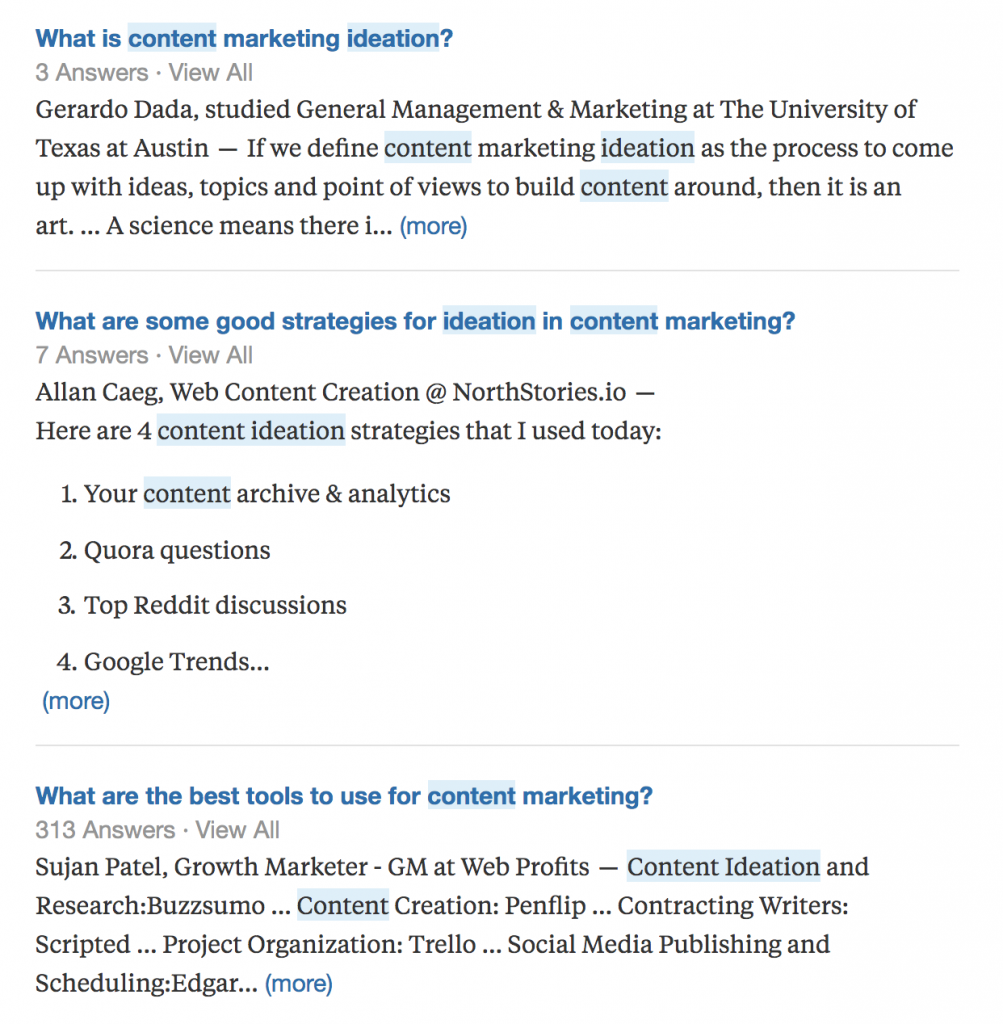
The screen gives me some fodder for what my content should cover to solve my readers’ problem. Put simply, networks such as Quora help you go beyond just selecting the trending or audience-loved topic. It provides highlights of what you can cover under the topic you pick.
Tools for getting the SEO nod
While it’s important to write for your audience, it is also crucial to please the search engine since it bridges the gap between you and your readers by driving traffic your way. 93% of all the online experiences begin with a search engine. It’s your best shot at getting found.
To get started in the SEO realm, here are some wicked tools to try:
- Ubersuggest: Neil Patel’s Ubersuggest is a free tool (woo-hoo!) that lets you learn how well a topic is searched. It gave me the following ideas for the term ‘content creation.’

- SEMrush: Works pretty much like Ubersuggest but pulls out more details. The screen below will give you an idea how:

- Bonus keyword research tactic: While this isn’t a tool, it is a great way to dive deeper into a topic. And it relates to Google, so it’s super easy.
First, type in your query and keep an eye on the suggestions that Google presents. These suggestions are based on widely searched queries. Thus, it will give you an idea of what people are searching for:
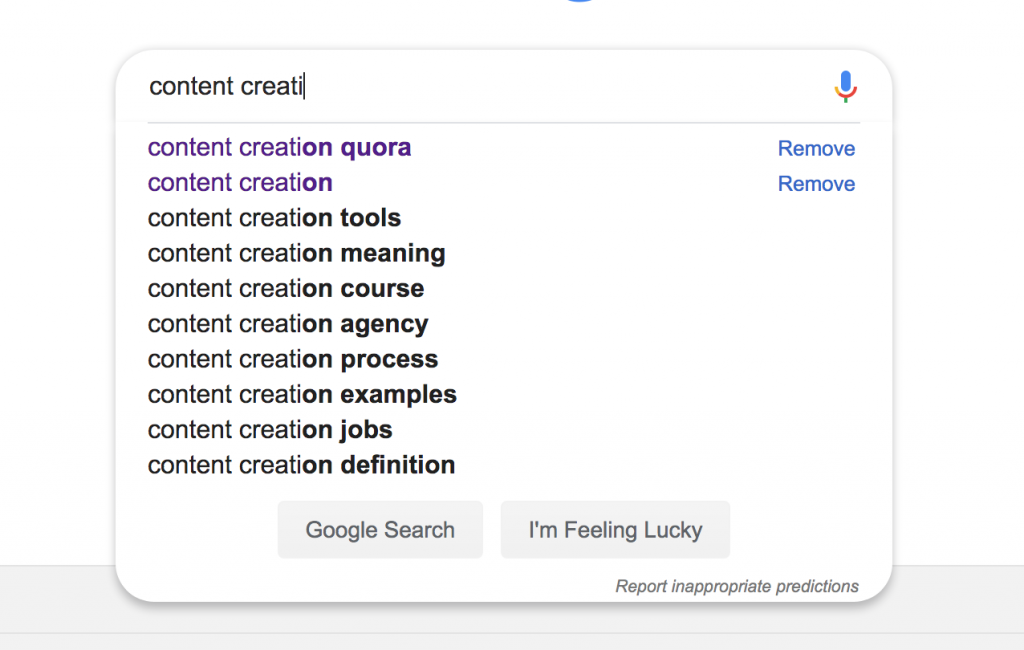
Second, go to the bottom of the results page, right down to the related searches. This right here are the secondary keywords you can add to your content as per audience demand:

Content ideation tools for planning out your topic
Now that both topic selection as per audience needs and SEO are out of the way, you will have to dig deeper into the topic you finalize.
Here, the following tools can help you:
Answer the Public: This tool is free (who doesn’t like that?) and simple to use. And it gives you the idea for sparking your idea plug. For the present topic, here some suggestions that Answer the Public made:

Bonus tactic: Read your industry’s work. Reading sparks a lot of great ideas.
Uno, it gives you an idea of what folks in your line of work are covering. And, as you read, you can see gaps in what has been discussed. When you note something that is lacking – boom! You’ve got the topic to target.
Duos, multiple inspirational topics can surface as well. For instance, I was working on a client’s work on blogging for business and noticed that I couldn’t find anything related to how blogging can help improve customer experience. That’s when I knew that I can add this idea to my interest list of content topics.
Taking another step in the content ideation funnel – social listening
As a key component of audience research, Hootsuite explains social listening as a way “to track, analyze, and respond to conversations about your brand and industry online.”
If we dissect this definition, you’ll note that social listening bears two chief fruits for you:
- Firstly, it helps you understand what customers and prospects are saying about you. If your customers are complaining or discussing any concerns related to you or your industry, you can use the matter as the subject for your content, helping solve your audience’s problem.
- Secondly, by following and tracking certain keywords related to your field, you can capture what folks are discussing and their pain points. This, in turn, gives you the seed for your content ideation phase.
Tools such as Hootsuite and others can help you listen, alerting you when your product or service is mentioned in the online sphere.
The focus here, however, is trained on employing social listening for content creation, which you can do without tools as well. For instance, head over to Quora (as discussed above) or Reddit to learn about the questions that people are asking. Try other social sites such as Twitter to gather more on the keyword.
Jot down your findings to come up with a brilliant idea for your content piece.
What’s more, it’s also a good idea to listen to other businesses in your line. It helps you comprehend what efforts they are putting, and how sweet a fruit their work is yielding.
When you’re listening to other brands though, try to strike a balance. An excess of listening to folks in your industry can leave you overwhelmed. Plus, you don’t want to C + P your content strategy. So, observe moderation.
Getting started with content creation
By now, you should already be having your content ideas baked, and your format decided. Now comes the part where you create content. Videos and other graphic content call for the need for a graphic designer or a video whizz.
For the written content, you’ll need a writer. Alternatively, you can work on writing your content as well.
Here are some tips to get you started and tools to fine-tune the entire content creation process:
Tips – how to start writing your content
Some days, writing can come easy. Other days, it takes a ton of effort to write out only a paragraph. Here’s what you can do:
- Begin with research work: Search for relevant content on the subject you’re going to cover. Also, look out for supportive studies and statistics to add to your work.
- Prepare an outline: It is entirely up to you to work out an outline and conduct research or conduct research and then prepare an outline. This depends on the way you work.
- Start with the draft: Once you have a solid outline, supportive research, and the tone of voice discussed, you can plunge straight into writing the draft. For your safety and protection from getting caught up with imposter syndrome, keep writing without turning back to see what you’ve done.
Pro Tip: Accept that the first draft will always be ugly unless you’re in luck.
- Let the draft rest: It’s always best to leave the draft as it is once you’ve it on paper or your laptop. By giving yourself and the draft some breathing space, you will be able to revisit the piece with a fresh pair of eyes and chop the fluff and other errors adequately.
- Edit the piece: Depending on how well your content was written in the first round, you can rewrite it completely, rewrite some sections, or edit the piece heavily until a final piece starts showing.
Editing tip: Make sure that your final content piece aligns with your business’s voice, is free from fluff and plagiarism and addresses readers’ pain points.
You also need to pay attention to how easy-to-read your content is. Here’s a resource that can help to make your content readable.
- Proofread your piece: Don’t forget to proofread your final piece at least twice before sharing it with your team and publishing
- Remove fluff from your writing: Don’t repeat yourself, write in active voice instead of passive voice, and remove redundant words from your draft
Hang on, what if a creator’s block suddenly strikes?
Everyone in the creative industry has some way to punch creator’s block out of their way. Rachel Moskowitz, the Social Media Strategist at Brafton notes that magazines and Pinterest are great sources of inspiration, which can help a person climb out of the murky water of the creator’s block.
Or, you can try some of these tricks to fight the block:
A3. I've found the following helpful for dealing with creator's block:
-Taking a walk. Fresh air is 👌
-Nap if you haven't slept wall
-Discuss with colleagues, peers, or anyone else
-Do something else, take your mind off that task
-Read something you like 🥰#BraftonBuzz https://t.co/64j8E85pcX— Masooma | Content Writer (@inkandcopy) February 27, 2019
Tools for the content creation process
A bank of tools can help you here, but I’ll share some helpful ones that I regularly use:
Tools for organizing your thoughts and content creation
- Pen + paper
One of the quickest and simplest ways to put your thoughts in one place is using the good ol’ pen and paper. Get a separate notebook for your content planning, ideation, and outline creation processes. Any ideas that strike can go over here, or you can add a different card for each idea on a Trello board.
Trello is my virtual office. It holds all projects that I align for the coming days, client content that is in progress, and work that needs review (editing and sharing with a respective client) along with a done tab.
With over 25 million users, Trello doesn’t need an intro, but for those who are new to it, it is a Kanban-style board where you can add columns. Under each column, you can add cards containing information about various projects.
Here is one of my boards where I track my blogs:
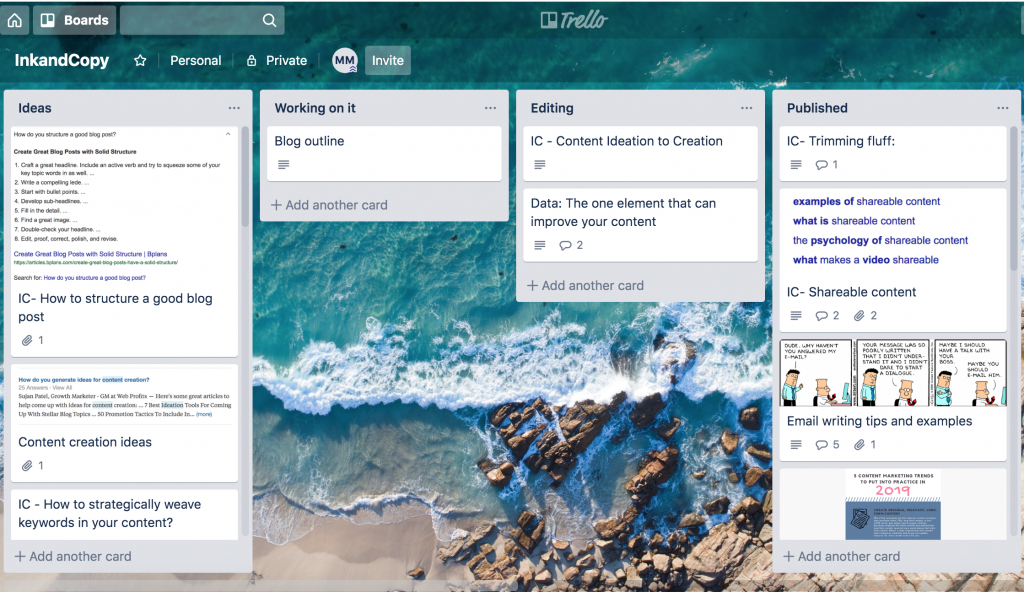
Tools for creating content
- Google docs
This one is a free blessing from Google that you can find in your Gmail account. It’s an advanced version of Microsoft Word, as Google Docs let you share the document with your team/client with a link.
By turning on your preferred settings, you can either open access to view or edit the doc. Here are your options:
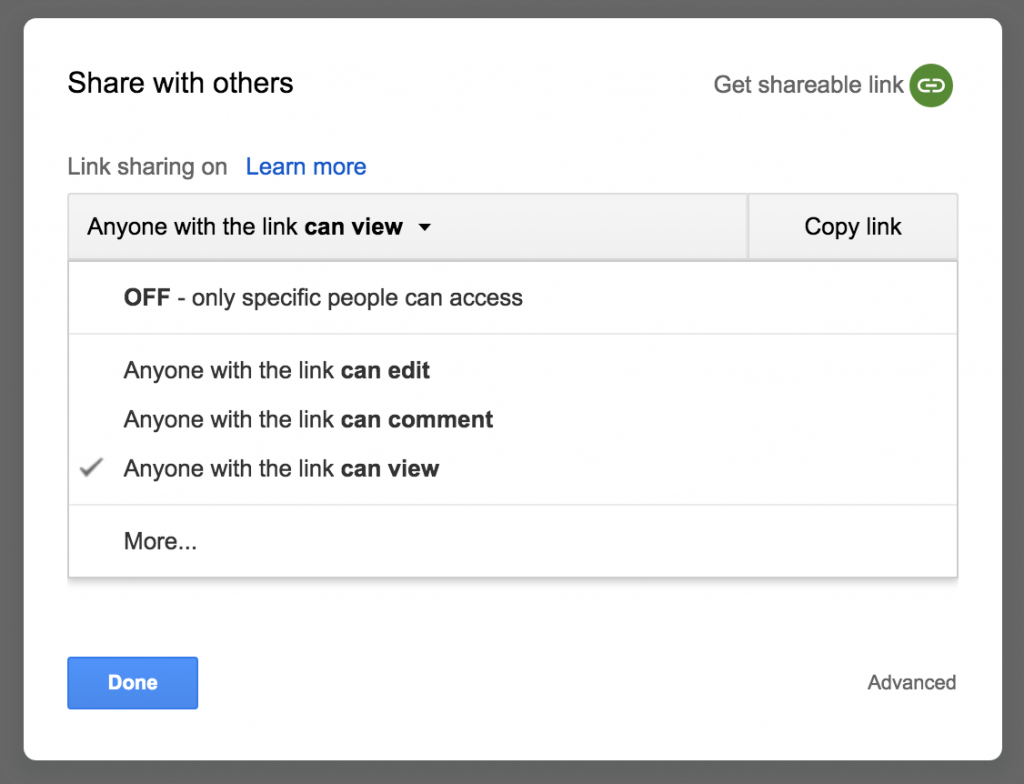
Grammarly has a free as well as a paid version. It is basically an editing app, which can help you polish your content by the following ways:
- Correct spelling mistakes with the app
- Rectify grammatical errors
- Check plagiarism and redundancy

The graphic for this blog is Canva’s work. It’s a user-friendly tool that can help you design graphics, social media banner, and infographics among other things. Again, you’ve the option of staying free or paying for advanced features.
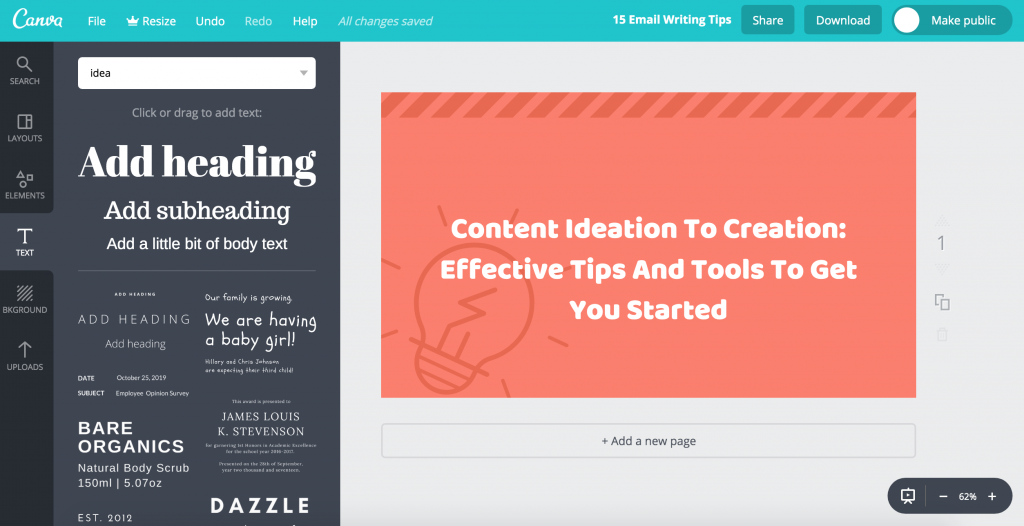
- Stock images sources
Buzzsumo analyzed 100 million articles and learned that those with images after every 75-100 words get the most shares. There’s nothing better than having high-quality images that you take on your own or someone with a keen eye shoots for you.
Alternatively, you can get stock images from the following sources:
With all these tools and tips, you should be good to get started with content creation.
If you need any help with your content creation process though, feel free drop me a message.

The best content marketing tool I’ve added to (not on many lists) is a free one called “INK for ALL”. To be able to pay all my bills, my clients require me to submit give or take 3-4 micro blogs a day so being able to use one tool instead of tons is like being in heaven.